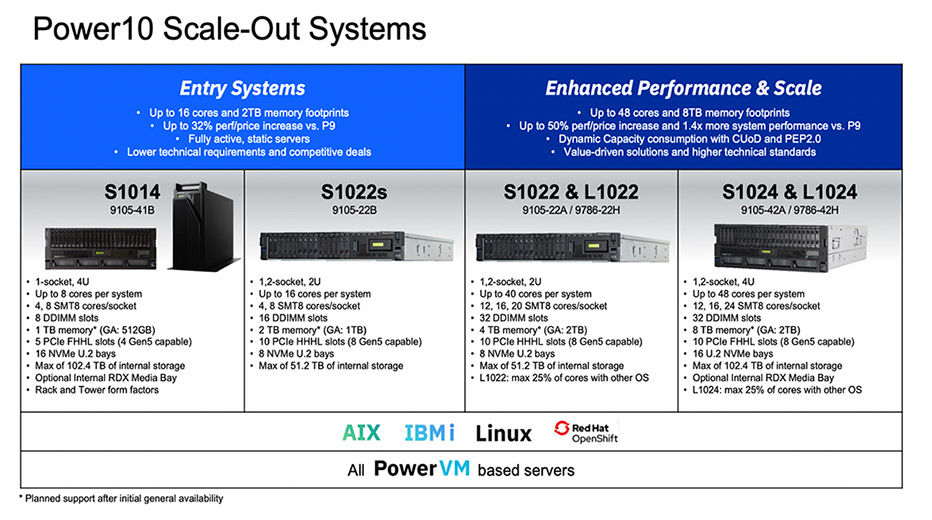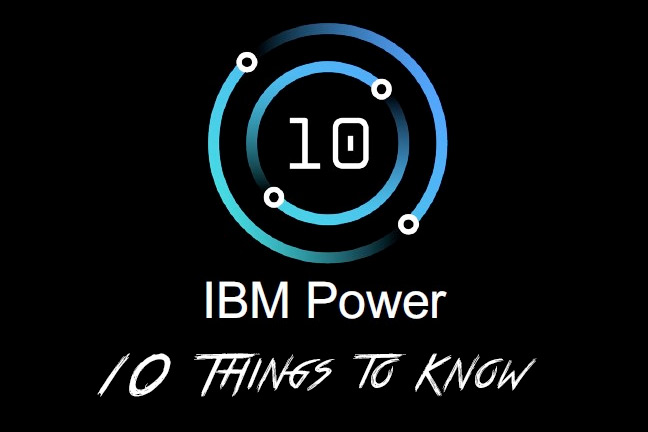Ron Gordon
Director, IBM Power Systems
IBM recently announced the much-anticipated Power10 based Scale Out and Mid-Range systems. With the Power Systems Enterprise 1080 being announced in September 2021, this announcement feels like the rest of the relatives have finally come to the family gathering for the holidays… lots of joy and celebration.
There were many servers announced and they follow the standard naming convention of the Scale Out families:
- S for Scale Out
- Architecture, 10 for Power10
- Number of sockets, 1 or 2
- Height of the 19-inch rack mounted systems, 2U or 4U
With this announcement, we now have the expanded IBM Power Systems Power10 server line with the S1014, the S1022s, the S1022, and the S1024 Scale Out systems.
To be noted, the Mid-Range 1050 however does not follow this convention but rather is a follow-on to the POWER9 based 950 with a 4 socket, 4U server.
10 Things to Know – The Common Features
Although there are certainly differences in the Scale Out and Mid-Range systems, there are many common features. Here is my list of 10 (with special unique notes) that apply to the new Power10 based Scale Out and Mid-Range systems:
1. All systems incorporate the Power10 processor in core count options from 12 down to 4 to allow cost/performance optimization. All systems also allow for the sockets to be installed with less than the full capability and grow by adding additional sockets as desired. The 1050 will require at least 2 sockets initially.
2. All sockets will now follow a Dual Chip Module (DCM) design. Each socket will have two Power10 processors (aka “chip”) where each processor must have the same core count. So, a 10-core chip (as in the S1022) will have two 10 core processors in the socket (total of 20 cores per socket) and since the system can have two sockets, capacity can be up to 40 cores on the system. In specific models (Power S1014 and Power S1022) the second processor in the DCM has no active cores but does support PCI sockets for maximum IO performance and capacity (but no additional DDIMMs).
3. Ghz is always a focus item by some. The systems have various Ghz capabilities based on cooling and core count factors. However, all systems will ship with the “max performance mode” and will run up to 3.90 or 4.0 Ghz. This can be changed to nominal mode in the HMC if the “full on” fans are too loud.
4. All memory will be the new DDIMMs (Differential DIMMs). These work in serial access as opposed to parallel and provide higher performance and improved RAS. At initial shipment, the largest capacity DDIMMs will not be available but are targeted for 4Q2022. DDIMMs sizes cannot be mixed on a system.
5. The FSP has been replaced by the eBMC on all Scale Out and Mid-Range systems. This will have the same EUI on the HMC as the previous FSP however the ASMI interface will change from previous FSP based systems.
6. All internal storage will be NVMe with up to 6.2 TB per NVMe adapter allowing up to 102 TB or internal storage per system. IO expansion draws are still supported with SAS and NVMe.
7. On the Scale-Out S1022 and S1024, IBM has introduced Capacity Upgrade on Demand (CUoD). This allows each system to be configured with less than the total core count capability. For example, if you utilize the 12-core chip on the S1024, the maximum capacity is 48 cores on the system. (Two 12-core chips per socket and two sockets, ((2×12) x2).) You can order the 48 cores system but only “activate” 24 cores (50% minimum activated required). This enables core counts (and software costs) to be optimized to workloads. As workloads grow, the “off” cores can be enabled as required, providing flexible consumption. However, this is NOT eCOD which has “on/off” capabilities at a per day cost. Once “on”, always on in CuOD, hence CuOD is NOT eCOD. This does not apply to the Mid-Range 1050 which is eCOD enabled nor does this feature apply to memory.
8. All newly announced Power10 based system can participate in Dynamic Capacity with Utility Pricing (aka Enterprise Pools 2.0). The Scale Out Power10 systems (S1022 and S1024) can reside in the same pools as the POWER9 Scale Out “G” models (922G and 924G) and the Mid-Range 1050 can co-reside with the 950 system.
9. All systems now have optional Active Memory Mirroring (redundant copy of the PHYP in memory) as well as other improved RAS functionality.
10. There are no Linux only models in the new Power10 Scale Out line-up. However, there is an “L” model “designed” for SAP HANA which will require Linux (75% or more) and up to 25% of AIX and/or IBMi.
Power10 Scale Out Systems
So with the above as a background on the new systems, here is a table with more information on the Power10 based Scale Out systems:

Power10 Mid-Range Systems
The Power10 Mid-Range 1050 has the following characteristics:
- 4 Socket 4U 19” rack mount
- 12, 18, 24 cores per socket
- Up to 16 TB RAM (TB maximum at GA)
- 11 PCIe Gen5 enabled slots
- 10 internal NVMe
- 3+1 Power Supply redundancy
- 3-year Warranty with Power Expert Care
Planned OS and HMC Versions Support
And lastly the Operating support table:

This article was intended to provide an overview this key IBM Power Systems announcement. For additional information in the areas of Power10 technology, RAS, rPerf/CPW information, general availability dates, systems management software updates, etc. please contact me or your Mainline representative for a conversation or a meeting.
More Information
Mainline is a Platinum level IBM Business Partner – the highest partnership level in the IBM PartnerWorld program. We have heavily invested in the technical skills and certifications necessary to provide the top level of services and solutions to our customers for all IBM hardware and software products, including maintenance and software support services. For further assistance with IBM Power10 servers contact us here.
You may be interested in:
BLOG: Upgrade Planning for IBM Power Enterprise Pools
BLOG: IBM Power Systems Software – New and Improved Functionality
BLOG: IBM Power Systems May 2022 Software Announcements Progress Capabilities

